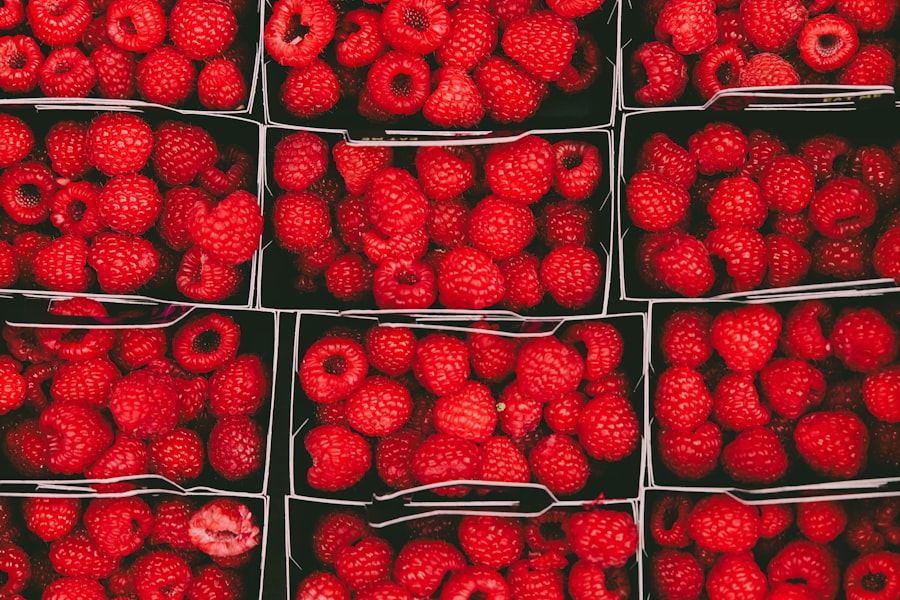Planting Red Onions: A Step-by-Step Guide

Red onions are a staple ingredient in many cuisines around the world. Their distinct flavor and vibrant color make them a popular choice for adding depth and complexity to dishes. In addition to their culinary uses, red onions are also a great addition to any garden. They are relatively easy to grow and can be a rewarding addition to your homegrown produce. In this blog post, we will explore everything you need to know about growing and cooking with red onions.
Key Takeaways
- Choosing the right red onion variety is important for your garden’s success
- Preparing the soil properly before planting is crucial for healthy growth
- Timing is key when planting red onions to ensure optimal yield
- Follow step-by-step instructions for planting red onions correctly
- Watering and fertilizing red onions properly will lead to healthy growth and optimal yield
Choosing the Right Red Onion Variety for Your Garden
When it comes to choosing the right red onion variety for your garden, there are a few factors to consider. Different varieties of red onions have different characteristics, such as size, flavor, and storage life. Some popular varieties include Red Baron, Red Bull, and Red Zeppelin. Red Baron is known for its mild flavor and good storage capabilities, while Red Bull has a stronger flavor and is great for use in salads or sandwiches. Red Zeppelin is a larger variety that is perfect for grilling or roasting.
When selecting a red onion variety for your garden, it’s important to consider your climate and growing conditions. Some varieties are better suited for colder climates, while others thrive in warmer regions. Additionally, consider the size of the onions you prefer and how long you want them to store. By taking these factors into account, you can choose a red onion variety that will thrive in your garden and meet your culinary needs.
Preparing the Soil for Planting Red Onions
Red onions require well-draining soil with a pH level between 6.0 and 7.0. Before planting, it’s important to prepare the soil to create the optimal growing conditions for your red onions. Start by removing any weeds or debris from the planting area. Then, loosen the soil using a garden fork or tiller to a depth of at least 8 inches.
Next, amend the soil with organic matter, such as compost or well-rotted manure. This will improve the soil’s fertility and drainage. Spread a layer of organic matter over the planting area and mix it into the soil using a garden fork or tiller. Finally, rake the soil to create a smooth surface for planting.
When to Plant Red Onions: Timing is Key
| Timing | Temperature | Soil Moisture | Seed Depth |
|---|---|---|---|
| Early Spring | 50-75°F | Moist, but not waterlogged | 1/4-1/2 inch |
| Late Summer/Fall | 60-75°F | Moist, but not waterlogged | 1/4-1/2 inch |
Timing is key when it comes to planting red onions. The best time to plant red onions is in early spring, as soon as the soil can be worked. Red onions are cool-season crops and prefer temperatures between 55°F and 75°F. Planting too early in cold soil can lead to poor germination and stunted growth.
Factors that affect the planting time of red onions include your location and climate. If you live in a colder climate, you may need to start your red onion seeds indoors and transplant them outdoors once the weather warms up. On the other hand, if you live in a warmer climate, you may be able to plant red onion sets directly in the garden in early spring.
How to Plant Red Onions: Step-by-Step Instructions
Planting red onions is relatively straightforward. Here is a step-by-step guide to help you get started:
1. Prepare the soil as mentioned in section

2. If starting from seeds, sow them indoors 8-10 weeks before the last frost date or directly in the garden once the soil has warmed up.
3. If using onion sets (small bulbs), plant them directly in the garden at a depth of 1 inch and space them 4-6 inches apart.
4. If using transplants, dig a small hole in the prepared soil and place the transplant in it, making sure that the top of the bulb is level with the soil surface.
5. Space transplants 4-6 inches apart.
6. Water thoroughly after planting to settle the soil around the bulbs.
Watering Red Onions: Best Practices for Healthy Growth
Proper watering is essential for the healthy growth of red onions. They require consistent moisture, but overwatering can lead to rot and disease. Here are some best practices for watering red onions:
1. Water deeply once a week, providing enough water to moisten the soil to a depth of 6-8 inches.
2. Avoid frequent shallow watering, as this can lead to shallow root growth.
3. Mulch around the plants to help retain moisture and prevent weed growth.
4. Monitor the soil moisture levels and adjust your watering schedule accordingly. Red onions prefer evenly moist soil, but they don’t like to sit in waterlogged conditions.
Fertilizing Red Onions: Tips for Optimal Yield
Red onions have specific nutrient requirements for optimal growth and yield. Here are some tips for fertilizing red onions:
1. Before planting, incorporate a balanced fertilizer into the soil according to the package instructions.
2. Side-dress the plants with a nitrogen-rich fertilizer, such as blood meal or fish emulsion, once they have established and started growing.
3. Repeat the side-dressing every 4-6 weeks throughout the growing season.
4. Avoid over-fertilizing, as this can lead to excessive foliage growth at the expense of bulb development.
Managing Pests and Diseases in Red Onion Plants
Like any garden plant, red onions are susceptible to pests and diseases. Common pests that affect red onion plants include onion maggots, thrips, and aphids. Diseases that can affect red onions include onion rot, downy mildew, and pink root.
To prevent pest and disease problems, practice good garden hygiene by removing any infected or infested plants promptly. Use row covers or insect netting to protect young plants from pests. Rotate your crops each year to prevent the buildup of pests and diseases in the soil. Additionally, avoid overwatering, as this can create favorable conditions for disease development.
Harvesting Red Onions: Signs of Readiness and Techniques
Knowing when to harvest red onions is crucial to ensure that they have reached their full flavor and storage potential. Here are some signs that red onions are ready for harvest:
1. The tops of the onions have turned yellow and started to fall over.
2. The necks of the onions have become soft and dry.
3. The outer skin of the onions has become papery and dry.
To harvest red onions, gently loosen the soil around the bulbs using a garden fork or trowel. Lift the bulbs out of the ground, taking care not to damage them. Once harvested, allow the onions to dry in a warm, well-ventilated area for 2-3 weeks before storing.
Curing and Storing Red Onions: Post-Harvest Care
Curing and storing red onions properly is essential to extend their shelf life and maintain their quality. Here are the steps to properly cure and store red onions:
1. After harvesting, remove any excess soil from the onions, but do not wash them.
2. Allow the onions to dry in a warm, well-ventilated area for 2-3 weeks.
3. Once the outer skin is dry and papery, trim off the tops and roots.
4. Store the cured onions in a cool, dry place with good air circulation.
5. Avoid storing red onions near fruits or vegetables that produce ethylene gas, as this can cause them to spoil faster.
Creative Ways to Use Red Onions in Cooking and Recipes
Red onions are incredibly versatile and can be used in a variety of dishes. Here are some ideas for using red onions in cooking:
1. Add thinly sliced red onions to salads for a pop of color and flavor.
2. Caramelize red onions and use them as a topping for burgers or sandwiches.
3. Pickle red onions in vinegar and use them as a condiment for tacos or grilled meats.
4. Roast red onions with olive oil, salt, and pepper for a delicious side dish.
5. Use red onions in stir-fries, soups, stews, and pasta dishes for added flavor.
Growing and cooking with red onions can be a rewarding experience. By choosing the right variety, preparing the soil properly, and providing the right care, you can enjoy a bountiful harvest of flavorful red onions. Whether you use them in salads, soups, or as a topping for your favorite dishes, red onions are sure to add depth and complexity to your culinary creations. So why not give growing and cooking with red onions a try? You won’t be disappointed!
If you’re looking for more information on how to plant red onions, be sure to check out this helpful article on Lawn World’s website. They have a comprehensive guide that covers everything you need to know about planting and caring for red onions. From choosing the right soil to proper spacing and watering techniques, this article will provide you with all the tips and tricks you need for a successful onion harvest. Don’t miss out on this valuable resource – click here to read the article now! https://www.lawnworld.com/how-to-plant-red-onions
FAQs
What is the best time to plant red onions?
The best time to plant red onions is in the early spring or fall, when the soil is cool and moist.
What type of soil is best for planting red onions?
Red onions grow best in well-drained soil that is rich in organic matter. The soil should have a pH level between 6.0 and 7.5.
How deep should I plant red onion bulbs?
Red onion bulbs should be planted about 1 inch deep in the soil, with the pointed end facing up.
How far apart should I space red onion bulbs?
Red onion bulbs should be spaced about 4-6 inches apart in rows that are 12-18 inches apart.
How often should I water red onions?
Red onions should be watered regularly, about 1-2 inches per week. However, be careful not to overwater as this can lead to rotting.
When should I harvest red onions?
Red onions are ready to harvest when the tops begin to yellow and fall over. This usually occurs in late summer or early fall.



